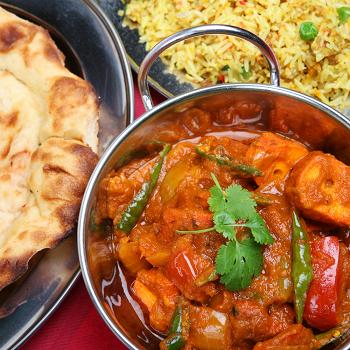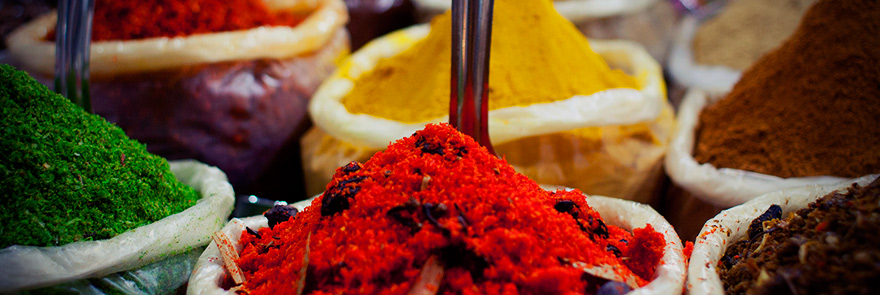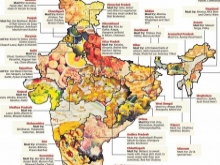India Food Tours
It’s the locals that know where to find the great Indian food, whether on the streets of Mumbai, inside Delhi’s dining scene, or an old regal city in the desert. And it’s the locals that lead the discovery on India food tours. Over the years we’ve identified the guides and chefs that best know how to help international visitors explore Indian cuisine. We arrange invites to taste true home cooking, give you the chance to help out in award-winning kitchens, reserve tables at contemporary restaurants and show you the secrets of ancient recipes. Our luxury India tours operate across the country and as befitting the cuisine, they’re individually tailored to your interests and tastes.
Much More Than India Culinary Tours
Some people visit India and love the food. Others find it a challenge. The reason for this is usually the level of spice, particularly the fiery flavors found in the most typical dishes. But we don’t accept that Indian cuisine is in the love it or hate it bracket, for it’s impossible to define a singular Indian dish. Everyone’s palate reacts differently, so on all our India luxury tours we have a diverse approach to dining. We can guide you to excellent restaurants with an international focus, the flavors of India fused with the elegance of French cooking being just one example. Or we can lead you into local restaurants that celebrate the raw authenticity of cuisine. Of course, there can be cooking classes, market tours, street food crawls and more. But most of all, we want to help guide your discovery, presenting the meals and experiences that can make India’s cuisine loved by all.

INDIA IS A VAST COUNTRY where cuisine varies from region to region, strongly influenced by religion, custom, history and geography. Indeed, a popular saying in India is "The food (and culture) changes every hundred kilometers." When the Moguls invaded in the sixteenth century, they brought Central Asian Muslim cuisine, largely based on meat. Their influence was strongest in North and Central India where meat dishes are best. Farther south, where Mogul influence was slight, the cooking is mainly vegetarian, except in those coastal pockets where Christian, Zoroas-trian, Jewish and Muslim influence has pre-dominated. India's regional cooking is also influenced by the staple food of the area. In the North, where wheat grows, the food is dryer and the sauces thicker than in the South, where rice is the staple diet. This is because Indian's eat with their fingers, and with the help of a chapati, flat, unleavened whole-wheat bread, it is easier eat dishes. The more liquid curries arc better eaten with rice, which is more absorbent. Climate, too, plays its part and the South, with its heavier rains.
For vegetarians, Indian cuisine is a wonderland of fresh tastes far from the usually bland and repitiative dishes at home. A plethora of spices and tasty sauces add zing and robust flavors to vegetables and dishes like palak paneer made of spinach and cheese may tempt even the most ardent of meat eaters.
Indian Cuisine by Region

North India Cuisine
Influenced by geography, North Indian cuisine is a combination of regional cuisines including Punjabi, Mughali, Kashmiri, and Rajasthani.
The signature dishes, North India curries have thick, moderately spiced and creamy sauces, while dairy products such as milk and yogurt are an integral part in many dishes, adding richness and to help cool spices. Flatbreads such as roti and paranthas are a mouth watering compliment.
North India Dishes Not to Miss
Delhi
Tandoori Chicken, Paranthe, Chaat, Nagauri-Halwa, Chole-Bhature
Mughlai Cuisine* Mughlai Cusine is known for its richness and exotic use of spices, dried fruit, and nuts. The Mughals did everything in style and splendor. Mughlai dishes as they are called have lots of milk and cream with spices to make it rich and spicy.
Biryani
An aromatic rice dish cooked with several spices, notably saffron, and a protein (typically chicken or mutton) that’s been marinated. Best place to try: Udaipur
South Indian Cuisine
Kerala
Sadya meal, Avial, Malabar Parotha, Payasam, and Irachi Stew are highlights of Kerala dishes.
Awadhi Cuisine
This cuisine consists of both vegetarian and meat dishes that employ the "dum" style of cooking over a slow fire that has become synonymous with the North Indian city of Lucknow. Awadhi food uses a fine blend of spices to create unique and delicious dishes which have been handed down from generations. The slow-fire cooking lets the food cook in its own juices, thus imparting a unique flavour. In addition to the major process of cooking food in Awadhi style, other important processes, such as marinating meats, contribute to the taste. This is especially the case with barbecued food that are cooked in a clay oven of over an open fire.
Awadhi cuisine is the main cuisine in this part of Northern India. It belongs to Lucknow and the style of cooking is similar to the Middle East, Central Asia and Northern India. Awadhi cuisine doesn’t rely on too many spices but rather uses a blend of few exotic spices. The food is cooked on slow fire so that the solids absorb the juices completely thereby ensuring the nutrients of the food are not lost. Some of the popular Awadhi dishes include Awadhi Chicken Dum Biryani, Chicken Korma, Dum Pukht Galouti Kebab, Mutton Korma, Shami Kebab.
In the orientation session, delve into the secrets of what makes Awadhi cuisine so irresistibly tempting and delicious. Find out if it is the concoction of aromatic spices or the dry fruits that add a distinctive taste to any vegetarian or non-vegetarian dish. Gather more about the Mughlai style of cuisine, which is influenced by Persian culture and has mesmerized food lovers all around the world with its delectable delicacies.
Discussion on such amazing cuisines is sure to whet your appetite, so get prepared to savor an assortment of Awadhi starters with your evening drinks, while an expert shares with you the intricacies of Awadhi and Mughlai dishes.
Later in the evening, enjoy a spread of traditional Awadhi dishes at the hotel’s specialty restaurant, Oudhyana. Savor the aroma and the flavors of Awadhi dishes and also receive an insight from a curator into how each of the dishes has been prepared and what makes them different from Mughlai and Hyderabadi.After all that wonderful food, it is time for you to hit the bed. Enjoy a peaceful overnight stay at the hotel. Overnight at our hotel.
Gujurat Cuisine
Gujarati cuisine features vegetarian dishes, including plates with roti, daal, kadhi, rice, sabzi, papad, and chaas (buttermilk). Sabzi, a dish of different combinations of vegetables and spices, may be stir-fried, and be spicy or sweet.
India Standout Restaurants
Delhi
Indian Accent
A must dinign experience on yoru trip trhough New Delhi. Situated in a small boutique hotel, award-winning chef Manish Mehrotra is driving his vision of contemporary New Delhi cuisine in bold and new ways. Manish is renowned for fusing of international ingredients and techniques with complex, traditional flavors of India to create unqiue dishes including foie gras stuffed galawat, masala miso scottish salmon, and chili bacon soft shell crab. Menu sample (pdf), Web: www.indianaccent.com
Notable Indian Chefs
Anjum Anand
"Elegant and softly spoken Anand is the new face of Indian cuisine, a bestselling author and entrepreneur who managed to knock Harry Potter off his perch with her breakthrough volume, Indian Food Made Easy, in 2007." u>Further reading

The Land of Spices
|
India has been aptly the called the Land of Spices. Indeed, no country produces as many varieties of spices found in India and is reflected in the complexity of the cuisine. Indian cuisine is spicy and subtle, noted for its six different flavors—sweet, salty, bitter, sour, astringent and spicy—all typically present in a meal.
These six flavors in Indian dishes are a bold mix for the senses with exciting aromas, bright colors, and complexity of spicy, sweet, and tangy flavors. For non-native cooks Indian cuisine can be intimidating when viewing ingredients required to cook most Indian dishes. If this is you, read on below.
Spices in Indian Cooking
Contrary to thought, most Indian dishes are not curries "Curry" has in fact become a popular name for any Indian meat or vegetable dish with a spicy sauce and in many Western markets are spices named curry, which are actually a blend of spices for convenience.
Indian food is not all strong spice and heat. There are many spices, but not always chili but rather cumin, tumeric, cardamom with just as common a mix of fragrant and peppery spices. Thus, cuisine in India features an astonishing range of flavors, marked by a deep knowledge of the abundant use of spices. There are about two dozen spices that are used in many popular dishes including ginger, cumin, but adding complexity is there are an exponential number of ways to combine them. Dishes like curries, for example, may be moist or dry, red or green, mild or hot (or very, very hot).
Cooking Indian at Home
The main key to cooking Indian is using the right spices with a critical process of ’blooming’ them, simply meaning cooking spices in oil or butter (or for an authentic taste use ghee, an Indian clarified butter). Blooming brings out the full flavor spices and more powerfully transfers their taste to whatever they are mixed in with.
Chicken curry is popular and a basic dish to begin your foray into cooking Indian cuisine at home. Compliment it with also easy to prepare dal (a stew made with lentils, or peas, or beans). Roti, a pizza dough like flat bread, rounds out this simple and traditional meal.
Other simple ways to introduce the cuisine of India into your home are to add spices and flavors to meals you already enjoy. For example, add two or three Indian spices such as cumin, tumeric, ginger, or chili peppers to your roasted chicken or stir fried vegetables.
Resources
Indian Chicken Curry Recipe on All Recipes Web Site
Indian Food Forever for all things about Indian Cooking
For more recommendations, log on to our client page below.

Ready To Get Started on your luxury India food tour? Submit a contact request form below, or call us:
San Francisco at or (415) 418-6800 , or in Asia contact us at (84-4) 3562-6665
![]()


